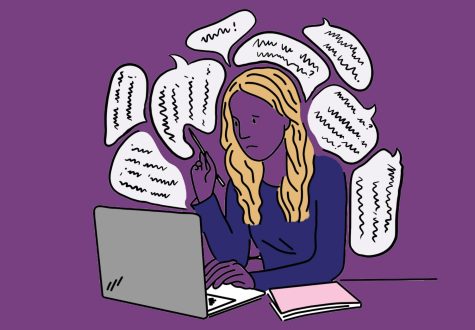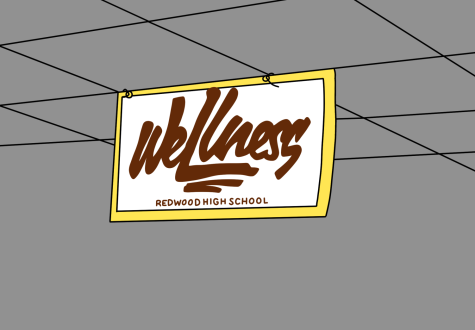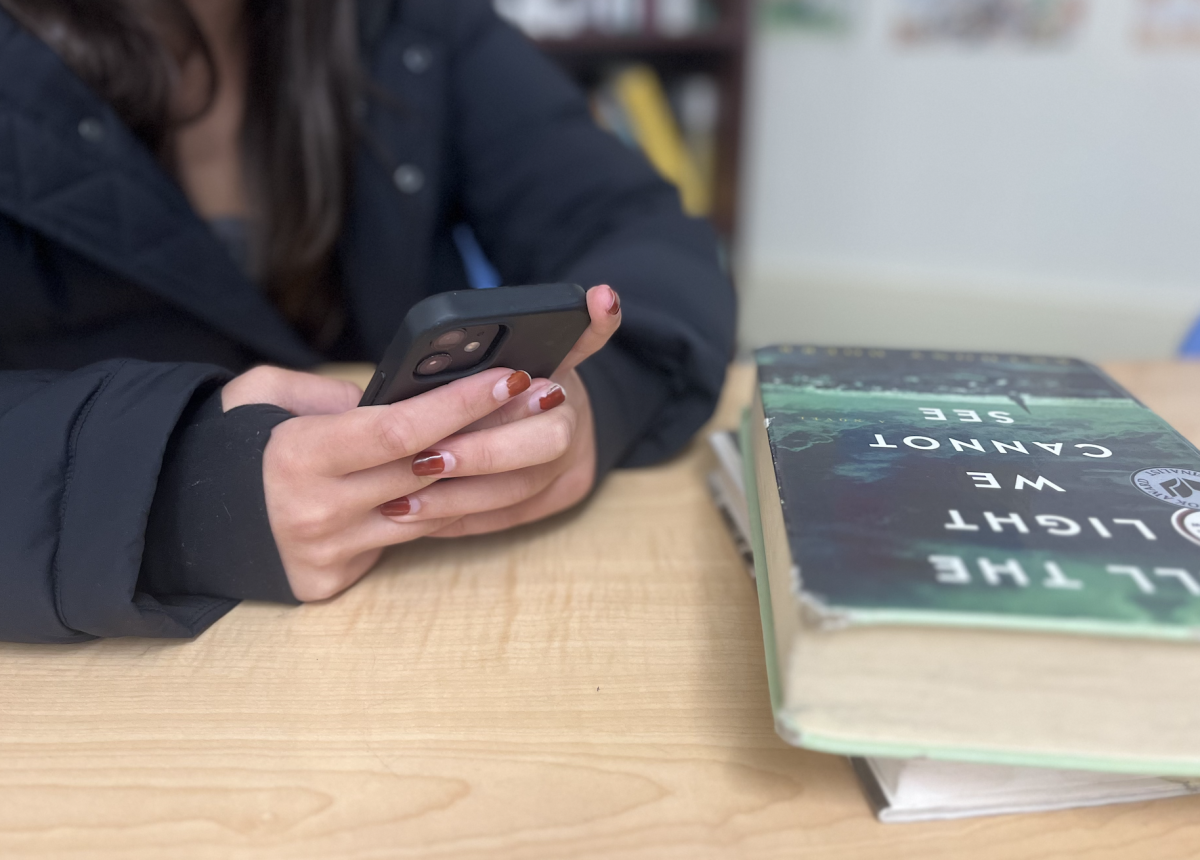“Addressing a past trauma in class is not an ideal place to address it, or for it to come up,” District Wellness Director Jessica Colvin said. “When we’re talking about trauma, we often don’t know how our bodies are going to react. It can feel physically unsafe and even cause a panic attack.”

Sensitive materials, including discussions of race, gender, ethnicity, mental illness, religion, politics, sexuality and disability, are frequently presented in high school classrooms, especially in humanities courses. Exposure to sensitive content may cause students with trauma to experience severe physical and emotional reactions, such as agitation, anxiety, dissociation and panic attacks. This phenomenon is not rare, as 35 percent of students report consuming content in school that caused them emotional or physical distress, according to an October 2022 Bark survey. Trauma can be defined as the lasting adverse effects on an individual after experiencing a deeply disturbing event. Despite the dangerous reactions that some students may have when interacting with traumatic content, many educators continue to believe that the presentations of these educational materials are imperative.
Josh Chan, a Redwood alumnus and former president of the Mental Health Awareness Club, values high school teachers who are mindful of their lessons’ potential effects on students’ mental health.
“I have to commend the few teachers that give warnings … especially when you look at different readings throughout history you’re bound to come across really sensitive topics. I think it’s important for there to be communication between students and teachers when they [will be discussing] these topics, because you never know when someone in the room is actively going through [a difficult time],” Chan said.
As a current junior at the University of California, Santa Barbara, Chan appreciates how his professors typically post a syllabus outlining the topics discussed in each class and providing students with ample notice to prepare for sensitive material or opt out for an alternative assignment.
Locally, San Andreas High School, one of five schools in the Tamalpais Union High School District (TUHSD), often creates assignments to accommodate students with trauma. Currently, 60 students are enrolled at San Andreas, many of whom struggled with a traditional learning style at the larger schools due to their trauma or anxiety. To support these students, San Andreas fosters a unique, trauma-informed school culture that refrains from cold-calling students or imposing anxiety-inducing assignments.
Dominique Uskert, the social studies teacher at San Andreas, recognizes many benefits to this modified style of learning, including the creation of a safe learning environment.

“You need to create a classroom where your students feel like they can be heard, be seen, share their ideas and where they’re not anxious. If I’m creating a hostile environment, [students] won’t want to come back the next day. They won’t be able to even get the point of my lesson,” Uskert said. “[Not only is it] damaging to my long-term relationship with [students], but it’s damaging to their learning that day.”
Uskert’s experience in teaching students with heightened levels of trauma has informed her of the best ways to teach in accordance with these sensitivities. To her, providing advance content warnings is the most effective path to building trust with students.
“Just last week I knew I was going to talk about something that would be personally challenging for one of my students to hear, so I let him know a day in advance and I said, ‘This is what I’m planning on covering. If you feel uncomfortable, I completely understand if you want to opt out of class that day,’ instead of making a blanket statement like, ‘You can stand up and walk out of the room if this is hard for you,’ because that could be even harder to do,” Uskert said.
Along with early content warnings, in some cases, she adjusts her lessons to ensure her students are receiving honest content in a sensitive manner.
“I want to be really mindful that a lot of our students have lived through fairly traumatic experiences and they don’t want to come to school and be traumatized even more,” Uskert said. “[Recently], I was creating an assignment [about] indigenous peoples and the role of women and how they are revered in certain tribes. … I was explaining things that had to do with male dominance and there was a reference to rape. When I was writing it out, I changed the language because [rape] is such a harsh word to hear. Not to shy away from things, but to make sure that I’m presenting [the lesson] in such a way that is really mindful.”
While Uskert acknowledges that Redwood’s significantly larger classroom sizes present challenges for teachers to give the same level of individual attention to each student’s background and needs, she suggests ways to mitigate damaging responses to sensitive material. For her, this includes taking note of students’ body language, facial expressions and how often they leave the classroom during potentially sensitive content. She then follows up with her students if she notices a pattern of discomfort.
Math teacher and instructional coach at San Andreas, Chris French, participates in committees to discuss and amend teaching tactics and their alignment with the district’s equity mission as part of his position. French does not see the difference in class sizes between San Andreas and Redwood as an explanation for educators being less cautious.
“In terms of bigger classes, yes, there are 30 students in the class, but there’s a small percentage of those students that are having consistent issues with anxiety or things that are shutting them down. There are ways to find that information without seeming invasive or making the students feel ‘othered,’” French said.
Uskert finds an effective way to get to know students both at the beginning and throughout the year is by asking students, “I wish my teacher knew ___.” This allows her to identify areas of content or assignment types that may cause stronger emotional reactions in different students. While some Redwood teachers conduct surveys at the beginning of the year, regularly offering inquiry-based questionnaires can lead to progressively more authentic responses as trust builds between the student and the teacher.
French also recognizes the power of consistent surveys and check-ins in order to build trusting relationships with students.
“If all teachers are doing [regular surveys], then all teachers are developing a level of trust in their students [and giving off a message that] the teachers here get it. The teachers at Redwood are trying to look out for others. And it is a lot of work, but at the same time if students aren’t learning, then it’s the work that’s worth putting in [for teachers],” French said.
He also advises that teachers familiarize themselves with the everyday struggles that increasing numbers of teens are facing. For example, trends in adolescent mental illness are spiking, and these mental health declines are expanding to become a public health issue, largely prominent in Generation Z. In a 2020 survey conducted by McKinsey & Company, a global management consulting firm, results showed that members of Generation Z were two to three times more likely than other generations to plan or attempt suicide.
“We’ve been given so much information as educators and as a society about what teens struggle with,” French said. “What teens are going through is not what I went through. What teens are going through now is totally different and our job is to absorb all of that because our job is to support teens. We have to get inside their heads in a way that makes them feel supported, seen and understood, so they feel like they can trust us.”
Redwood’s Wellness Center connects students with professionals who are knowledgeable about current trends in teens’ mental health. Catherine Stern, a Bay Area Community Resources (BACR) therapist who works in the Wellness Center, perceives extensive warnings in classrooms as unproductive to creating a safe learning environment.
“It’s important to be able to see something uncomfortable, hear something uncomfortable and manage it,” Stern said. “The more we avoid [trauma], the stronger it gets.”
Stern also acknowledges that schools are safe spaces equipped with resources and adults who can help students, and therefore, are the ideal place for exposure to sensitive material.
“In order [for athletes] to grow [and] build strength, the muscles have to be challenged. And that’s true for emotions too,” Stern said. “If you were a baby, and all your needs were met the minute you needed them, if you were never hungry, if you never had any physical discomfort, you would never grow. You would never learn how to manage yourself.”
Wellness director, Colvin, also agrees that sensitive content is crucial to include in high school classes, provided that teachers do so mindfully.
“My hope is that when we’re talking about sensitive topics in school, our students are getting an unbiased education to make healthier decisions in their lives. It’s really important that schools continue to educate around sensitive topics, but you have to do so really carefully and thoughtfully,” Colvin said.
Wellness staff frequently visit classes to educate about different mental health issues, such as eating disorders, binge drinking and suicide.
“The research shows that if a student is already suicidal, talking about it does not increase their chances of becoming more suicidal, it actually increases their chances of getting help. That being said, it doesn’t mean it’s not going to bring up hard feelings for people, or have them think about something they’ve never thought about before or had the words to describe,” Colvin said.

However, Colvin observes that while open conversations about suicide can be helpful for students coming to terms with mental struggles, or assist them in their journey toward receiving help, other topics may warrant more caution.
“We often teach about self-harm really carefully because there are certain topics that you don’t want to be ‘contagious.’ … You don’t ever want to give someone ideas on how to start an eating disorder or how to start self-harming. … The aim is to keep people healthy and safe,” Colvin said.
Because mental health professionals emphasize the importance of continuing to teach sensitive material, the question is how to ensure students are benefitting from these lessons. French finds that consistent content warnings and a supportive, safe classroom environment may incline students with trauma to listen to difficult lessons.
“A student starts to think about a [positive] connection they have with a teacher and may think, ‘You know what, this teacher’s got my back so I’m gonna sit here.’ But [again,] it takes a culture of trust and accountability,” French said.
For those who want to process or step away from sensitive content shown in class, Redwood’s Wellness Center is available throughout the school day to provide support and counseling.















